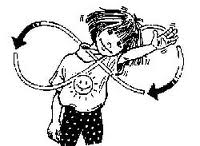Developing emotional intelligence skills and empathy at the English lessons
Developing emotional intelligence skills and empathy at the English lessons
Aims:
- to demonstrate the most effective practices for developing emotional
intelligence and empathy;
- to show practical usage of these tools at the English lessons.
Equipment:
- magic pillow;
- cards of emotions;
- pillows for meditation;
- mirrors;
- motivational slogans.
Procedure
Introduction (2 min.)
It’s not a secret that some years ago in a world of achievements and results a focus was made on rational intelligence, while the emotional state of a personality was ignored, but at the same time it was widely used in commercial and trade needs for impact on customers choices.
A simple definition of emotional intelligence (also called the emotional quotient) describes an ability to monitor your own emotions as well as the emotions of others, to distinguish different emotions correctly, and to use emotional information to guide your thinking and behavior.
We use emotional intelligence to empathize with our students, have deep conversations about our relationship and attempt to manage an unruly and naughty child. It allows us to connect with others, understand ourselves better and live a more authentic, healthy and happy life.
According to Daniel Goleman, there are five components of emotional intelligence:
- Self-awareness (the ability to recognize and understand your own emotions).
- Self-regulation (the ability to express, regulate and manage feelings and emotions).
- Empathy (the ability to understand other people`s feelings).
- Social skills (successful interaction with one another).
The most effective tools among the variety of different ways of developing emotional intelligence skills while teaching are:
- Mindfulness
- Art-therapy
- Nonviolent communication
- Fairy-tale therapy
- Breathing exercises
- Song therapy
Activity 1. “Acquaintance. Expectations. Magic pillow” (4 min.)
As usual, we feel ourselves more comfortably, relaxed and emotionally stable before going to bed. Today we have got a magic pillow, which you will pass from one to another. When you hold the magic pillow you say your name and expectations from our today`s meeting. When determining expectations and desires, feel the softness of the pillow, safety, comfort and harmony that you usually feel before going to bed.
You should remember that one of the components of a successful lesson is a good mood of students and teachers, the benefits of positive emotions, what surrounds students in a particular environment.
Motivational slogans, the rules of the lessons made by students, their own drawings and creative works will contribute to the positive microclimate in the classroom, the perception of students and their full inclusion in the process.
Activity 2. “Emotions” (4 min.)
One of the components of emotional intelligence is the recognition of your own emotions and thoughts related with them and the most useful practice here is the attention developing. Therefore, it is justified that "Mindfulness", as attentiveness and awareness, forms the basis of emotional intelligence.
You have got a set with the image of a face and “emotions”, which are usually expressed with eyes and a mouth. Choose the emotions that prevail right now. Listen to yourself. Name them. Explain, why do you feel so right now? And now, throwing a cube of emotions, describe the emotion that fell to you, in which situations do you usually feel them?
Activity 3. “The box of happiness” (2 min.)
In order to teach students to distinguish between positive emotions and concentrate on them, I propose now to create in your imagination a box of happiness and to put in it things that make you happy, when you see, hear, taste, smell and touch them.
Example:
• Seeing: I am happy when I see colorful leaves in sunny weather.
• Hearing: I am happy when I hear the sound of the sea.
• Tasting: I am happy when I taste sweets.
• Smelling: I am happy when I smell coffee.
• Touching: I am happy when I touch my favorite pet.
Activity 4. “Google with your eyes” (4 min.)
Now sit comfortable on the pillows, support your previous emotion that prevailed, take 10 deep breaths in full silence, feel what happens to every part of your body when you fill it with oxygen, make sure you notice what surrounds you and what makes you calm. Close your eyes, recall the objects around you and with your hands show the location of a subject that I will name out (the clock, the board, the door, the window, the group rules, the red chair, the green marker, etc.).
Activity 5. “Kinezological activities for getting away of emotional intense and arising our mood” (2 min.)
LAZY EIGHTS

Extend one arm straight out in front of you, with the thumb pointing toward the ceiling. In the air, smoothly and slowly trace the shape of a large figure 8 on its side.
As you draw the 8, focus your eyes on your thumb, keeping your head upright, facing forward and moving only slightly. Start tracing your 8 by beginning at eye level. Move your arm up and over to the left, around and back to centre, then to the right.
Do three full 8s with one hand, then three with the other and finally three with both hands clasped together.
** This integrates both visual fields, improving balance and co-ordination. Many people report better vision after this exercise.
And now let’s relax, watch a video and train our brain. Video “brain gym”.
Activity 6. “Fairy-tale therapy. Exercise "Emotions of characters” (5 min.)
You have already learned how to recognize and manage your own emotions, and now let's try to recognize the emotions and feelings of others.
You have small cards with symbolic images of different emotional states. Now you listen to a fairy-tale about a cheerful tongue, you will be its direct participants, and after listening, you will lay out a few cards on the table that, in your opinion, reflect the emotional state of our character in different situations. After the end, everyone can explain in what situation the character was cheerful, sad, and so on, and why you think so. Show me your tongues right now, take the mirrors that are in front of you, listen to the fairy-tale, follow me and do not forget what task have you got.
In the morning, the tongue woke up, stretched and opened the curtains on the windows: (w-w-w). The tongue saw that it was raining (t-t-t), a strong wind was blowing (u:-u:-u:), he was very upset and said (o-o-o). After all, today is his birthday, and yesterday he has called his friends (ei-ei-ei) to celebrate it with him on the nice clearing. The tongue sighed hard (h-h-h), sat down near the window and cried (i-i-i). Suddenly, he heard a knock on the door (d-d-d), opened them and said (wow-wow-wow). He saw his friends who brought him a cake and many colored balls. The tongue was very happy!
Demonstrate what kind of cards you have chosen to determine the emotional state of our character.
Activity 7. Song therapy “Baby shark”. (3 min.)
Pay attention to the color of your mirror, distinguish what positive emotion it arises in your mind. Now turn the mirror and see who was one of the friends who came to visit the tongue. This is a good shark that brought with it all its family. Those who have
-green mirrors - mommy shark
- red mirrors - baby shark
- blue mirrors - daddy shark
- pink mirrors - grandma shark
- white mirrors - grandpa shark
Make a group of these characters. We listen to the song for the first time, you will see what actions your character performs, then you will play them, all the other actions of the song, which do not have a certain character, we will perform together as one friendly team.
Activity 8. Art therapy. (7 min.)
Have a look who also has come to visit our cheerful tongue: a duck, a giraffe, a crocodile, a turtle and a butterfly. Choose one of the characters you like the most, draw it in an unusual way, with the shape of your hands. Paint your guest with the colors you like the best. After you finish, present your character, tell us what its name is, where it lives, what color it is and what mood it has.
Activity 9. Demonstration. (3 min.)
Activity 10. “Thanks circle, a ribbon to remember.” (4 min.)
Let`s make a circle. I want to invite you to take part in a small ceremony that will help us to express a feeling of friendship, gratitude to each other. Please take a ribbon of the color that suits your mood, tie down the knot, and say what has impressed you the most today. And now, one of you is in the center, the other approaches him, shakes his hand and says: "Thank you for a pleasant time!"
Thus, the group in the center of the circle is constantly increasing. Everyone holds each other hands. When the last participant joins your group, close the circle and finish the ceremony with a silent, durable three-time handshaking.


про публікацію авторської розробки
Додати розробку
